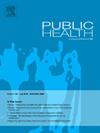Sex differences in the impact of social isolation and loneliness on mortality
IF 3.9
3区 医学
Q1 PUBLIC, ENVIRONMENTAL & OCCUPATIONAL HEALTH
引用次数: 0
Abstract
Objective
Social isolation and loneliness are increasingly recognized as risk factors for mortality, but their sex-specific effects remain unclear.
Study design
This study examines the impact of social isolation and loneliness and their combined association with all-cause, cardiovascular disease (CVD), and cancer mortality.
Methods
322,558 participants were analyzed from the UK Biobank cohort (51.3 % female, mean age: 55.66 ± 7.99 years; 48.7 % male, mean age: 56.53 ± 8.16 years). Social isolation and loneliness were assessed using validated measures. Mortality data were obtained from national death registries over a median follow-up of 11.83 years. Cox proportional hazards models estimated hazard ratios (HRs) and 95 % confidence intervals for mortality, adjusting for socioeconomic, behavioral, and health-related confounders.
Results
Social isolation was consistently associated with increased all-cause and CVD mortality in both sexes, with higher effect sizes in males (HR all-cause: 1.41 [95 % CI: 1.37–1.49]; CVD: 1.61 [1.45–1.80]) compared to females (HR all-cause: 1.25 [1.16–1.34]; CVD: 1.31 [1.08–1.58]). Loneliness was associated with increased all-cause mortality in females (HR: 1.12 [1.01–1.24]) but not in males (HR: 1.01 [0.94–1.10]). The combination of loneliness and social isolation yielded the highest mortality risks, particularly for CVD mortality. A significant interaction by sex was observed for all-cause mortality (p = 0.012), but not for CVD or cancer mortality.
Conclusions
Social isolation is a strong and independent predictor of mortality in both sexes, particularly for CVD-related deaths, while loneliness exerts a significant impact on overall mortality in females but not in males.
性别差异对社会隔离和孤独对死亡率的影响
社会孤立和孤独越来越被认为是死亡的危险因素,但其性别特异性影响尚不清楚。研究设计本研究探讨了社会隔离和孤独的影响,以及它们与全因、心血管疾病(CVD)和癌症死亡率的综合关系。方法对来自英国生物银行队列的322,558名参与者进行分析,其中51.3%为女性,平均年龄:55.66±7.99岁;男性48.7%,平均年龄56.53±8.16岁)。社会隔离和孤独感采用有效的措施进行评估。死亡率数据来自国家死亡登记处,随访时间中位数为11.83年。Cox比例风险模型估计了死亡率的风险比(hr)和95%置信区间,调整了社会经济、行为和健康相关混杂因素。结果社会隔离与两性全因死亡率和心血管疾病死亡率的增加一致相关,男性的效应量更高(全因死亡率:1.41 [95% CI: 1.37-1.49];心血管疾病:1.61[1.45-1.80]),而女性(全因HR: 1.25 [1.16-1.34];Cvd: 1.31[1.08-1.58])。孤独与女性全因死亡率升高相关(HR: 1.12[1.01 - 1.24]),而与男性无相关(HR: 1.01[0.94-1.10])。孤独和社会孤立的结合产生了最高的死亡风险,特别是心血管疾病死亡率。性别对全因死亡率有显著的相互作用(p = 0.012),但对心血管疾病或癌症死亡率无显著影响。社会隔离是两性死亡率的一个强有力且独立的预测因素,尤其是与心血管疾病相关的死亡,而孤独对女性的总体死亡率有显著影响,而对男性没有影响。
本文章由计算机程序翻译,如有差异,请以英文原文为准。
求助全文
约1分钟内获得全文
求助全文
来源期刊

Public Health
医学-公共卫生、环境卫生与职业卫生
CiteScore
7.60
自引率
0.00%
发文量
280
审稿时长
37 days
期刊介绍:
Public Health is an international, multidisciplinary peer-reviewed journal. It publishes original papers, reviews and short reports on all aspects of the science, philosophy, and practice of public health.
 求助内容:
求助内容: 应助结果提醒方式:
应助结果提醒方式:


